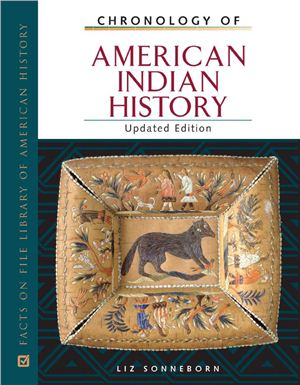Хронология истории американских индейцев.
Updated Edition. 2007. Язык английский.
According to oral tradition, the Navajo (Dineh) came into being by emerging through three
worlds—the Black World, the Blue-Green World, and the Yellow World—before finally reaching the Glittering World, the one they still inhabit in the American Southwest. This story, told from generation to generation for hundreds of years, is believed by some scholars to confirm their own theories of how the Navajo came to live in their homeland. According to archaeological evidence, the early Navajo traveled through the Arctic to central Canada and on to the Rocky Mountain region before settling in the lands they occupy today. In their creation story, the Black World seems to correspond to the cold, harsh environment of the Arctic, the Blue-Green
World to the Canadian forests, and the Yellow World to the mountains and plains on the Rockies’ easte slope.
Like the Navajo’s, the ancestors of all Indians experienced a southward migration in the distant
past, according to the Bering Strait Theory. The theory holds that during the last ice age, the waters of the strait separating Siberia from Alaska withdrew, exposing between Asia and North America a land bridge that ancient hunters unwittingly crossed while following herds of large game. (The ancestors of the Inuit and Aleut are believed to have arrived in North America during a much later migration, perhaps navigating the strait in skin boats. ) Although generally accepted by archaeologists and other scholars, some Indians contest the Bering Strait Theory, observing that their creation stories hold that their people were created in their traditional
homelands.
Once in North America, early Indians fanned across the continent, following herds of large game
they hunted for food. Beginning in about 11,000 B.C. , a warming climate forced changes in their way of life. With rising temperatures, game animals such as the mammoth and mastodon began to die out.
At the same time, new plants and animals emerged that were better equipped to survive in the changing environment. Indians themselves adapted by taking advantage of these new food sources. Living as gatherers and small-game hunters, they were able to inhabit all reaches of North America by about 9000 B.C.
CONTENTS.
- Before Emergence 1492 to 1606.
- Strangers Arrive 1607 to 1775.
- Natives and Newcomers 1776 to 1829.
- Surviving in Early America 1830 to 1865.
- The Removal Era 1866 to 1890.
- From Resistance to Reservations 1891 to 1933.
- The Dispossession Years 1934 to 1968.
- On the Road to Self-Determination 1969 to 1979.
- Protest and Revitalization 1980 to 1999.
- Growing Stronger 2000 to the Present.
- Into the 21st Century
- Glossary
- Works Discussed in Entries
- Selected Bibliography
- Index
Updated Edition. 2007. Язык английский.
According to oral tradition, the Navajo (Dineh) came into being by emerging through three
worlds—the Black World, the Blue-Green World, and the Yellow World—before finally reaching the Glittering World, the one they still inhabit in the American Southwest. This story, told from generation to generation for hundreds of years, is believed by some scholars to confirm their own theories of how the Navajo came to live in their homeland. According to archaeological evidence, the early Navajo traveled through the Arctic to central Canada and on to the Rocky Mountain region before settling in the lands they occupy today. In their creation story, the Black World seems to correspond to the cold, harsh environment of the Arctic, the Blue-Green
World to the Canadian forests, and the Yellow World to the mountains and plains on the Rockies’ easte slope.
Like the Navajo’s, the ancestors of all Indians experienced a southward migration in the distant
past, according to the Bering Strait Theory. The theory holds that during the last ice age, the waters of the strait separating Siberia from Alaska withdrew, exposing between Asia and North America a land bridge that ancient hunters unwittingly crossed while following herds of large game. (The ancestors of the Inuit and Aleut are believed to have arrived in North America during a much later migration, perhaps navigating the strait in skin boats. ) Although generally accepted by archaeologists and other scholars, some Indians contest the Bering Strait Theory, observing that their creation stories hold that their people were created in their traditional
homelands.
Once in North America, early Indians fanned across the continent, following herds of large game
they hunted for food. Beginning in about 11,000 B.C. , a warming climate forced changes in their way of life. With rising temperatures, game animals such as the mammoth and mastodon began to die out.
At the same time, new plants and animals emerged that were better equipped to survive in the changing environment. Indians themselves adapted by taking advantage of these new food sources. Living as gatherers and small-game hunters, they were able to inhabit all reaches of North America by about 9000 B.C.
CONTENTS.
- Before Emergence 1492 to 1606.
- Strangers Arrive 1607 to 1775.
- Natives and Newcomers 1776 to 1829.
- Surviving in Early America 1830 to 1865.
- The Removal Era 1866 to 1890.
- From Resistance to Reservations 1891 to 1933.
- The Dispossession Years 1934 to 1968.
- On the Road to Self-Determination 1969 to 1979.
- Protest and Revitalization 1980 to 1999.
- Growing Stronger 2000 to the Present.
- Into the 21st Century
- Glossary
- Works Discussed in Entries
- Selected Bibliography
- Index

